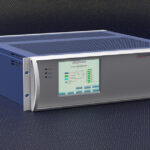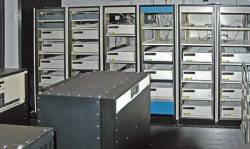Microchip’s 5071B is a compact commercial timing product offering ease of deployment across multiple industries
From everyday applications such as mobile phones and banking to complex underwater defense missions, the need for synchronized precise timing and frequency solutions is critical to safeguard and process data as intended. Many of these applications rely on Global Navigation Satellite Systems (GNSS) to provide that precise time and frequency, but GNSS is susceptible to jamming and spoofing attacks. To provide multiple industries—including telecommunications, data centers, metrology, aviation and defense—with a long-term and precise timing and frequency solution, Microchip Technology today announces the 5071B cesium atomic clock that can perform autonomous time keeping for months in the event of GNSS denials.
Microchip’s 5071B is the next-generation commercial cesium clock to the existing 5071A, which has been the primary contributor to international time for more than three decades. The 5071B is available in a three-unit height (3U) 19-inch rackmount enclosure, providing a compact product to work in environments where it can be easily transported and secured versus a larger alternative designed specifically for laboratory environments.
The 5071B has upgraded electronic components to address possible obsolescence or non-RoHS circuitry. The product provides 100 ns holdover for more than two months, maintaining system synchronization when GNSS signals like GPS are denied. For example, this capability would enable a 5G network to remain fully operational for months without GNSS.
“The 5071A has been the world’s premier time and frequency standard for decades. With the upgraded 5071B, Microchip continues its position as the industry leader in complex timing solutions,” said Randy Brudzinski, vice president, Microchip’s frequency and time systems business unit. “Our customers can rely on the 5071B’s technology for years to come and implement a timing and frequency solution with confidence in continuity of supply and modern components, which eliminates obsolescence concerns.”
As a cesium beam tube product with no deterministic long-term frequency drift, the 5071B provides absolute frequency accuracy of 5E-13 or 500 quadrillionths over all specified environmental conditions for the life of the product. For military applications requiring rapid deployments for system radars, 5E-13 stability eliminates the need for the acquisition of external synchronization sources prior to radiating. In satellite communications, this enables the user to broadcast and transmit over very small frequency bands without drifting out of band for the entire duration of the product.
When deployed, a product like the 5071B could maintain and better synchronize the critical communication between an aircraft and control tower. Air traffic control in the United States utilizes the Automatic Dependent Surveillance-Broadcast (ADS-B) and Wide Area Multilateration (WAM) to precisely locate the position of aircraft across the nation’s airspace. The stability of the 5071B enables more accurate locations and continued operation during GNSS outages.
The 5071B is now fully compliant with the Restriction of Hazardous Substances Directive (RoHS), making this product available in regions where regulatory policies are in place.
Microchip provides the broadest portfolio of clock and timing systems in the industry. Its state-of-the-art solutions are based on the company’s long heritage in the field of synchronization and timing and vertical integration of its core timing technologies.






